Case Study: Hofstede's Cultural Dimensions at Lee's Company
VerifiedAdded on 2020/03/07
|7
|1508
|76
Case Study
AI Summary
This case study analyzes the situation at Lee's company through the lens of Hofstede's five cultural dimensions. It explores how cultural differences, particularly in individualism versus collectivism, create challenges for Lee, an employee accustomed to Australian culture, working in a Korean workplace. The assignment examines how Lee's behavior, including his dress, work ethic, and communication style, clashes with the company's culture. It provides insights into the impact of power distance and uncertainty avoidance on employee interactions. The solution suggests strategies for Lee to adapt to the Korean work environment, including adjusting his appearance and work habits. Furthermore, it offers recommendations for the Korean manager on how to accommodate individualistic employees like Lee while maintaining a competitive advantage, such as assigning tasks that require less interaction with colleagues and fostering a more inclusive workplace culture. The case study utilizes Hofstede's theory to explain the cultural clashes and provides practical solutions for both the employee and the manager.
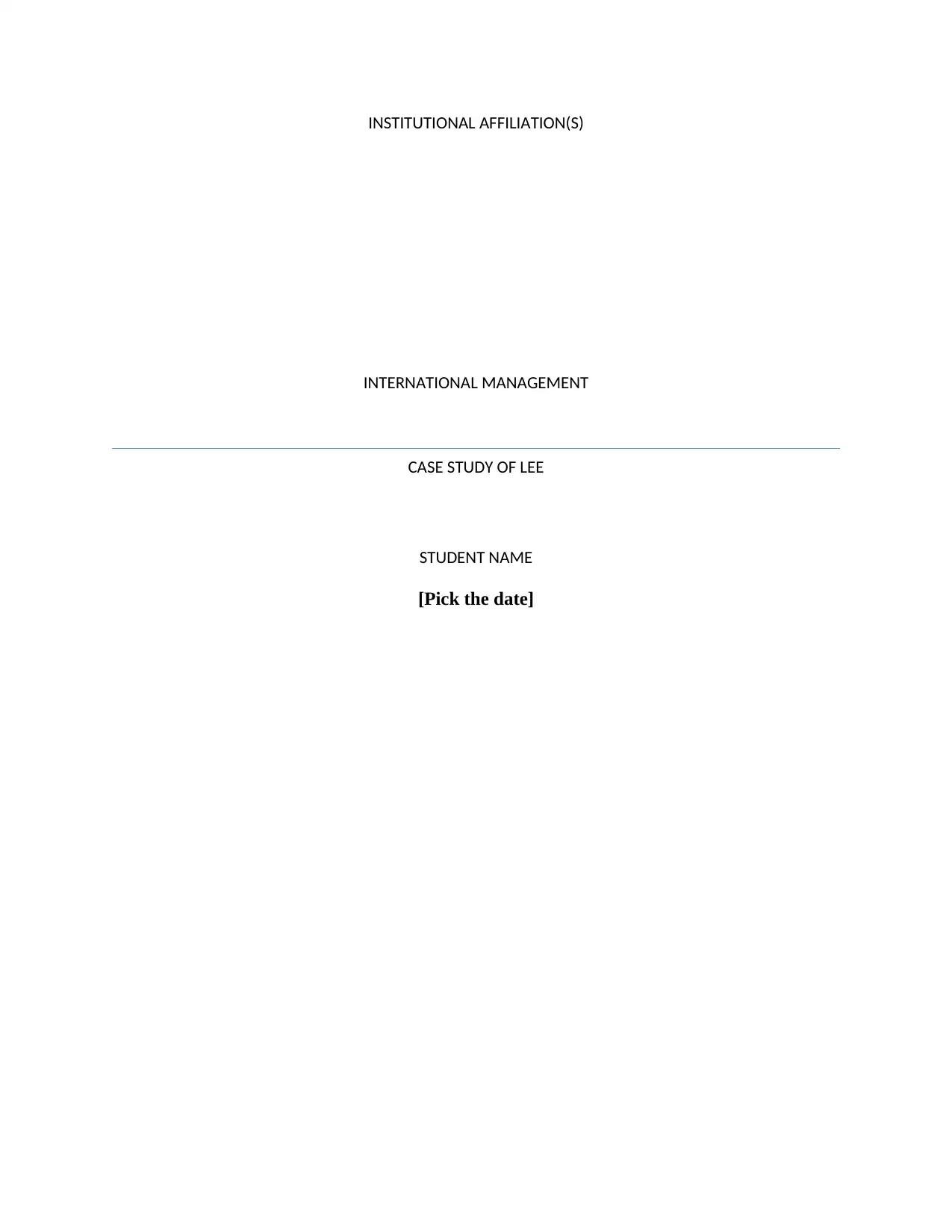
INSTITUTIONAL AFFILIATION(S)
INTERNATIONAL MANAGEMENT
CASE STUDY OF LEE
STUDENT NAME
[Pick the date]
INTERNATIONAL MANAGEMENT
CASE STUDY OF LEE
STUDENT NAME
[Pick the date]
Paraphrase This Document
Need a fresh take? Get an instant paraphrase of this document with our AI Paraphraser
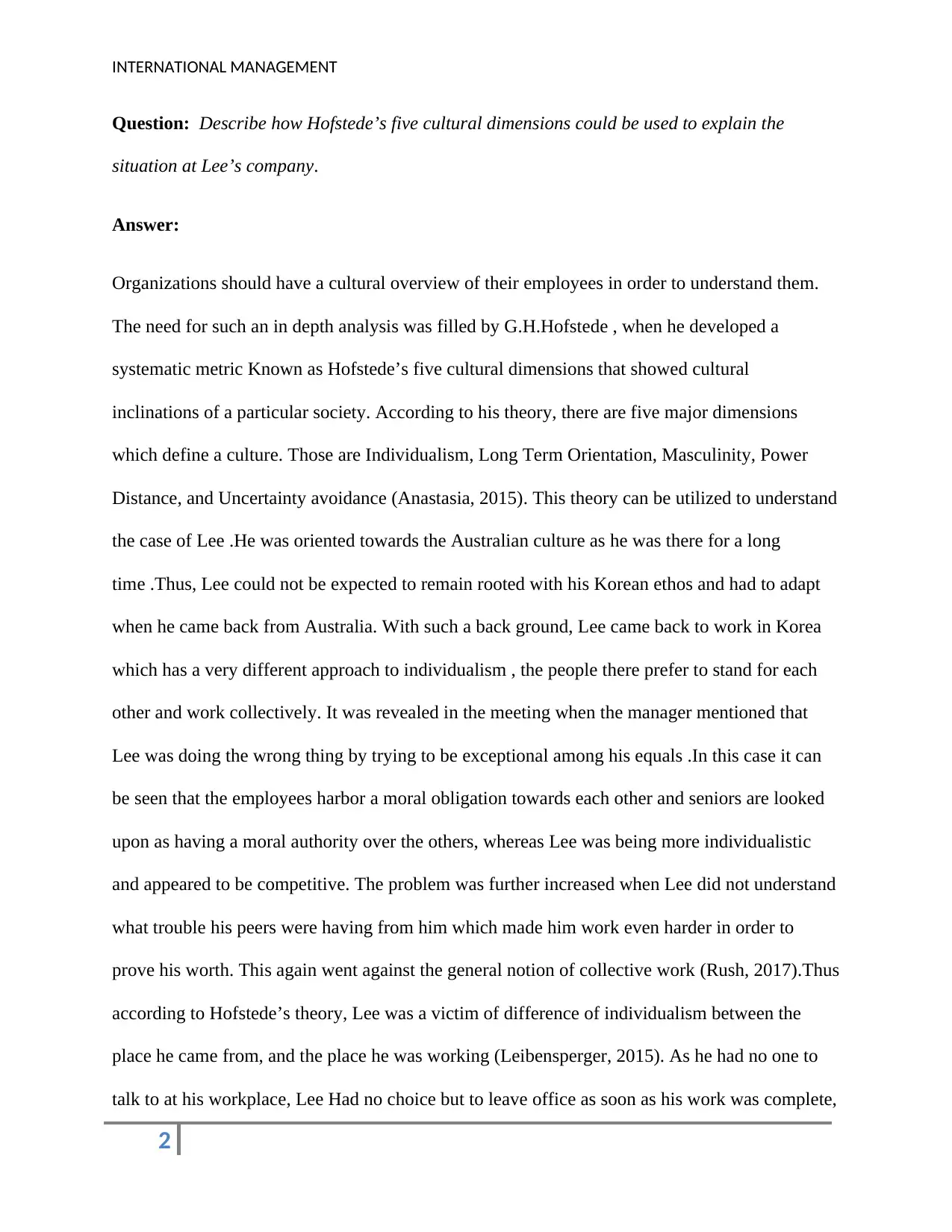
INTERNATIONAL MANAGEMENT
Question: Describe how Hofstede’s five cultural dimensions could be used to explain the
situation at Lee’s company.
Answer:
Organizations should have a cultural overview of their employees in order to understand them.
The need for such an in depth analysis was filled by G.H.Hofstede , when he developed a
systematic metric Known as Hofstede’s five cultural dimensions that showed cultural
inclinations of a particular society. According to his theory, there are five major dimensions
which define a culture. Those are Individualism, Long Term Orientation, Masculinity, Power
Distance, and Uncertainty avoidance (Anastasia, 2015). This theory can be utilized to understand
the case of Lee .He was oriented towards the Australian culture as he was there for a long
time .Thus, Lee could not be expected to remain rooted with his Korean ethos and had to adapt
when he came back from Australia. With such a back ground, Lee came back to work in Korea
which has a very different approach to individualism , the people there prefer to stand for each
other and work collectively. It was revealed in the meeting when the manager mentioned that
Lee was doing the wrong thing by trying to be exceptional among his equals .In this case it can
be seen that the employees harbor a moral obligation towards each other and seniors are looked
upon as having a moral authority over the others, whereas Lee was being more individualistic
and appeared to be competitive. The problem was further increased when Lee did not understand
what trouble his peers were having from him which made him work even harder in order to
prove his worth. This again went against the general notion of collective work (Rush, 2017).Thus
according to Hofstede’s theory, Lee was a victim of difference of individualism between the
place he came from, and the place he was working (Leibensperger, 2015). As he had no one to
talk to at his workplace, Lee Had no choice but to leave office as soon as his work was complete,
2
Question: Describe how Hofstede’s five cultural dimensions could be used to explain the
situation at Lee’s company.
Answer:
Organizations should have a cultural overview of their employees in order to understand them.
The need for such an in depth analysis was filled by G.H.Hofstede , when he developed a
systematic metric Known as Hofstede’s five cultural dimensions that showed cultural
inclinations of a particular society. According to his theory, there are five major dimensions
which define a culture. Those are Individualism, Long Term Orientation, Masculinity, Power
Distance, and Uncertainty avoidance (Anastasia, 2015). This theory can be utilized to understand
the case of Lee .He was oriented towards the Australian culture as he was there for a long
time .Thus, Lee could not be expected to remain rooted with his Korean ethos and had to adapt
when he came back from Australia. With such a back ground, Lee came back to work in Korea
which has a very different approach to individualism , the people there prefer to stand for each
other and work collectively. It was revealed in the meeting when the manager mentioned that
Lee was doing the wrong thing by trying to be exceptional among his equals .In this case it can
be seen that the employees harbor a moral obligation towards each other and seniors are looked
upon as having a moral authority over the others, whereas Lee was being more individualistic
and appeared to be competitive. The problem was further increased when Lee did not understand
what trouble his peers were having from him which made him work even harder in order to
prove his worth. This again went against the general notion of collective work (Rush, 2017).Thus
according to Hofstede’s theory, Lee was a victim of difference of individualism between the
place he came from, and the place he was working (Leibensperger, 2015). As he had no one to
talk to at his workplace, Lee Had no choice but to leave office as soon as his work was complete,
2
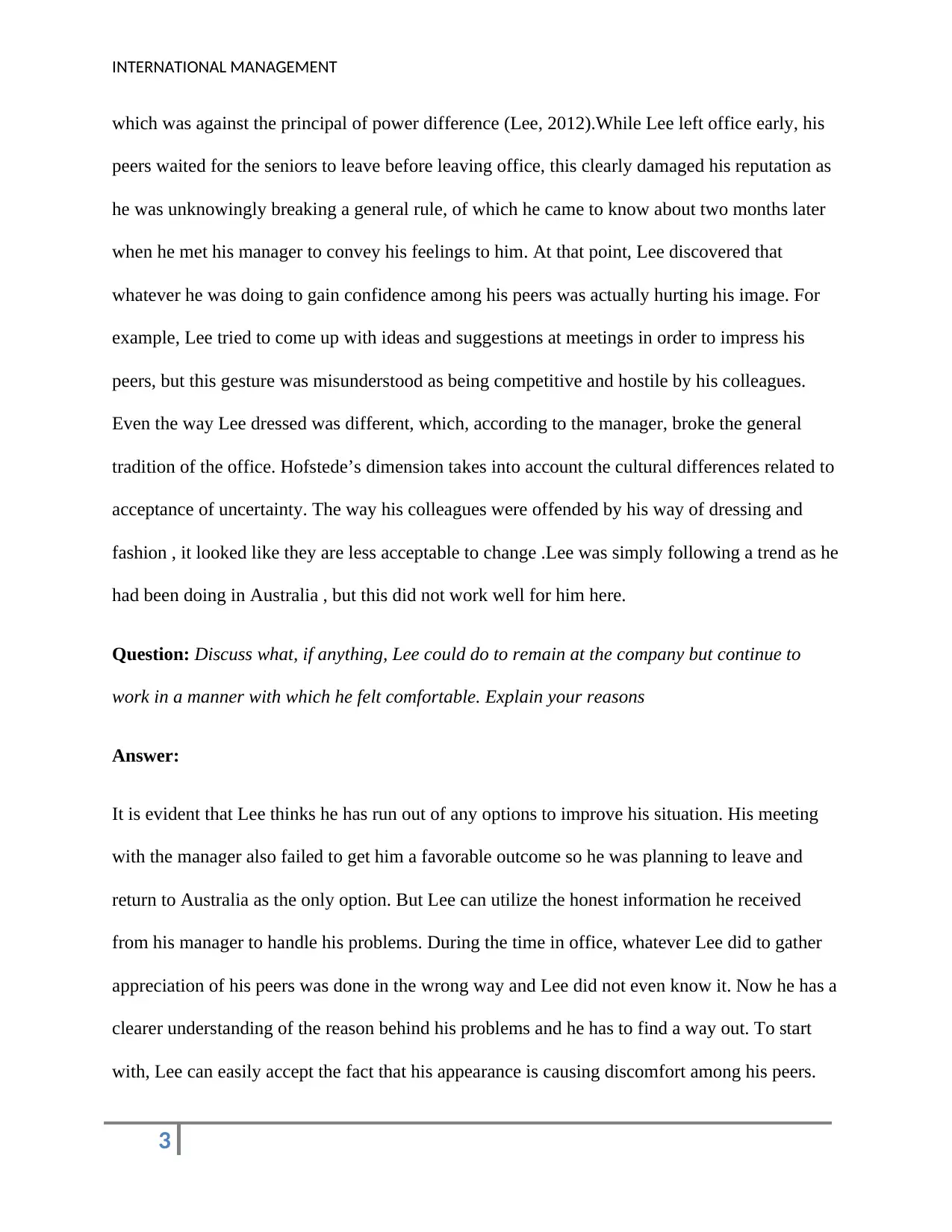
INTERNATIONAL MANAGEMENT
which was against the principal of power difference (Lee, 2012).While Lee left office early, his
peers waited for the seniors to leave before leaving office, this clearly damaged his reputation as
he was unknowingly breaking a general rule, of which he came to know about two months later
when he met his manager to convey his feelings to him. At that point, Lee discovered that
whatever he was doing to gain confidence among his peers was actually hurting his image. For
example, Lee tried to come up with ideas and suggestions at meetings in order to impress his
peers, but this gesture was misunderstood as being competitive and hostile by his colleagues.
Even the way Lee dressed was different, which, according to the manager, broke the general
tradition of the office. Hofstede’s dimension takes into account the cultural differences related to
acceptance of uncertainty. The way his colleagues were offended by his way of dressing and
fashion , it looked like they are less acceptable to change .Lee was simply following a trend as he
had been doing in Australia , but this did not work well for him here.
Question: Discuss what, if anything, Lee could do to remain at the company but continue to
work in a manner with which he felt comfortable. Explain your reasons
Answer:
It is evident that Lee thinks he has run out of any options to improve his situation. His meeting
with the manager also failed to get him a favorable outcome so he was planning to leave and
return to Australia as the only option. But Lee can utilize the honest information he received
from his manager to handle his problems. During the time in office, whatever Lee did to gather
appreciation of his peers was done in the wrong way and Lee did not even know it. Now he has a
clearer understanding of the reason behind his problems and he has to find a way out. To start
with, Lee can easily accept the fact that his appearance is causing discomfort among his peers.
3
which was against the principal of power difference (Lee, 2012).While Lee left office early, his
peers waited for the seniors to leave before leaving office, this clearly damaged his reputation as
he was unknowingly breaking a general rule, of which he came to know about two months later
when he met his manager to convey his feelings to him. At that point, Lee discovered that
whatever he was doing to gain confidence among his peers was actually hurting his image. For
example, Lee tried to come up with ideas and suggestions at meetings in order to impress his
peers, but this gesture was misunderstood as being competitive and hostile by his colleagues.
Even the way Lee dressed was different, which, according to the manager, broke the general
tradition of the office. Hofstede’s dimension takes into account the cultural differences related to
acceptance of uncertainty. The way his colleagues were offended by his way of dressing and
fashion , it looked like they are less acceptable to change .Lee was simply following a trend as he
had been doing in Australia , but this did not work well for him here.
Question: Discuss what, if anything, Lee could do to remain at the company but continue to
work in a manner with which he felt comfortable. Explain your reasons
Answer:
It is evident that Lee thinks he has run out of any options to improve his situation. His meeting
with the manager also failed to get him a favorable outcome so he was planning to leave and
return to Australia as the only option. But Lee can utilize the honest information he received
from his manager to handle his problems. During the time in office, whatever Lee did to gather
appreciation of his peers was done in the wrong way and Lee did not even know it. Now he has a
clearer understanding of the reason behind his problems and he has to find a way out. To start
with, Lee can easily accept the fact that his appearance is causing discomfort among his peers.
3
⊘ This is a preview!⊘
Do you want full access?
Subscribe today to unlock all pages.

Trusted by 1+ million students worldwide
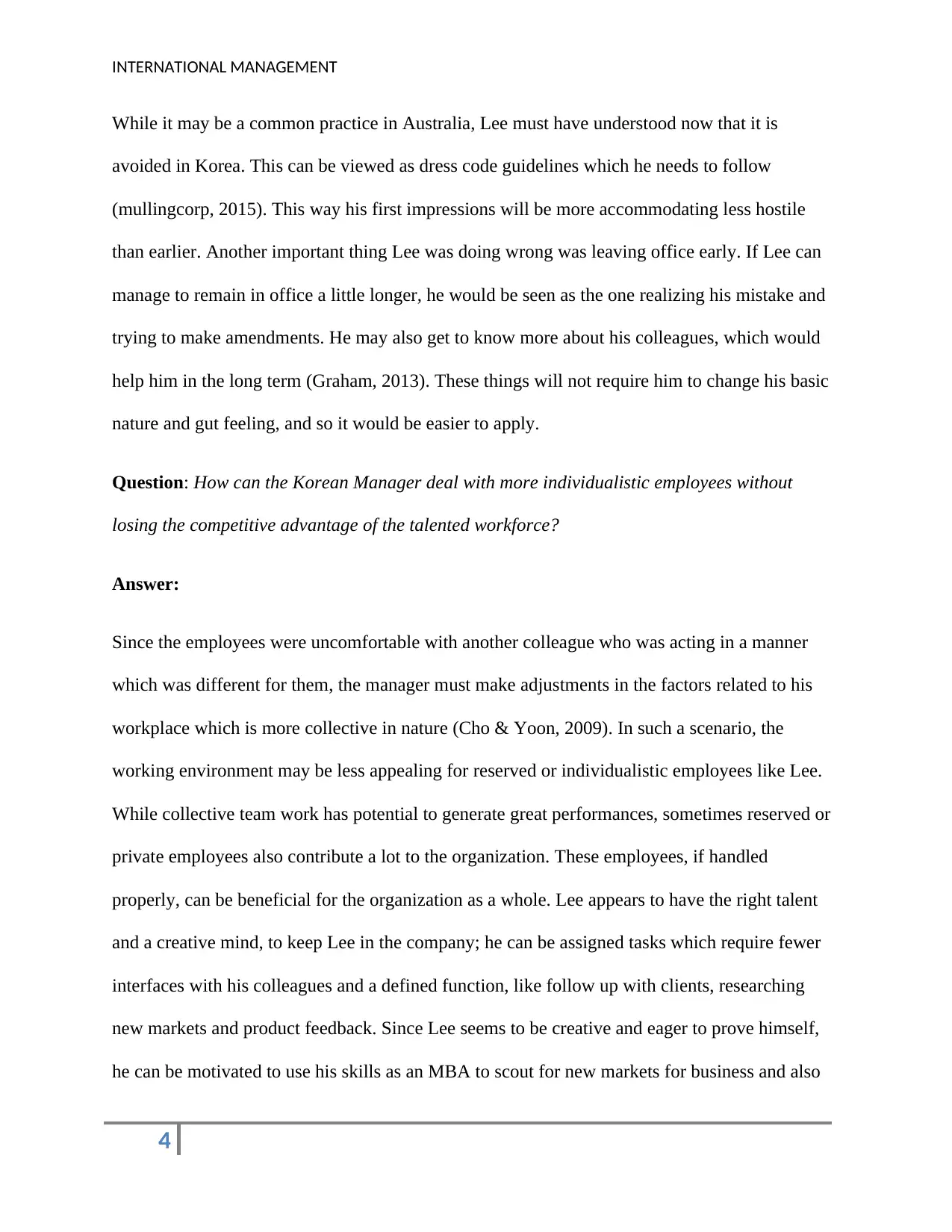
INTERNATIONAL MANAGEMENT
While it may be a common practice in Australia, Lee must have understood now that it is
avoided in Korea. This can be viewed as dress code guidelines which he needs to follow
(mullingcorp, 2015). This way his first impressions will be more accommodating less hostile
than earlier. Another important thing Lee was doing wrong was leaving office early. If Lee can
manage to remain in office a little longer, he would be seen as the one realizing his mistake and
trying to make amendments. He may also get to know more about his colleagues, which would
help him in the long term (Graham, 2013). These things will not require him to change his basic
nature and gut feeling, and so it would be easier to apply.
Question: How can the Korean Manager deal with more individualistic employees without
losing the competitive advantage of the talented workforce?
Answer:
Since the employees were uncomfortable with another colleague who was acting in a manner
which was different for them, the manager must make adjustments in the factors related to his
workplace which is more collective in nature (Cho & Yoon, 2009). In such a scenario, the
working environment may be less appealing for reserved or individualistic employees like Lee.
While collective team work has potential to generate great performances, sometimes reserved or
private employees also contribute a lot to the organization. These employees, if handled
properly, can be beneficial for the organization as a whole. Lee appears to have the right talent
and a creative mind, to keep Lee in the company; he can be assigned tasks which require fewer
interfaces with his colleagues and a defined function, like follow up with clients, researching
new markets and product feedback. Since Lee seems to be creative and eager to prove himself,
he can be motivated to use his skills as an MBA to scout for new markets for business and also
4
While it may be a common practice in Australia, Lee must have understood now that it is
avoided in Korea. This can be viewed as dress code guidelines which he needs to follow
(mullingcorp, 2015). This way his first impressions will be more accommodating less hostile
than earlier. Another important thing Lee was doing wrong was leaving office early. If Lee can
manage to remain in office a little longer, he would be seen as the one realizing his mistake and
trying to make amendments. He may also get to know more about his colleagues, which would
help him in the long term (Graham, 2013). These things will not require him to change his basic
nature and gut feeling, and so it would be easier to apply.
Question: How can the Korean Manager deal with more individualistic employees without
losing the competitive advantage of the talented workforce?
Answer:
Since the employees were uncomfortable with another colleague who was acting in a manner
which was different for them, the manager must make adjustments in the factors related to his
workplace which is more collective in nature (Cho & Yoon, 2009). In such a scenario, the
working environment may be less appealing for reserved or individualistic employees like Lee.
While collective team work has potential to generate great performances, sometimes reserved or
private employees also contribute a lot to the organization. These employees, if handled
properly, can be beneficial for the organization as a whole. Lee appears to have the right talent
and a creative mind, to keep Lee in the company; he can be assigned tasks which require fewer
interfaces with his colleagues and a defined function, like follow up with clients, researching
new markets and product feedback. Since Lee seems to be creative and eager to prove himself,
he can be motivated to use his skills as an MBA to scout for new markets for business and also
4
Paraphrase This Document
Need a fresh take? Get an instant paraphrase of this document with our AI Paraphraser
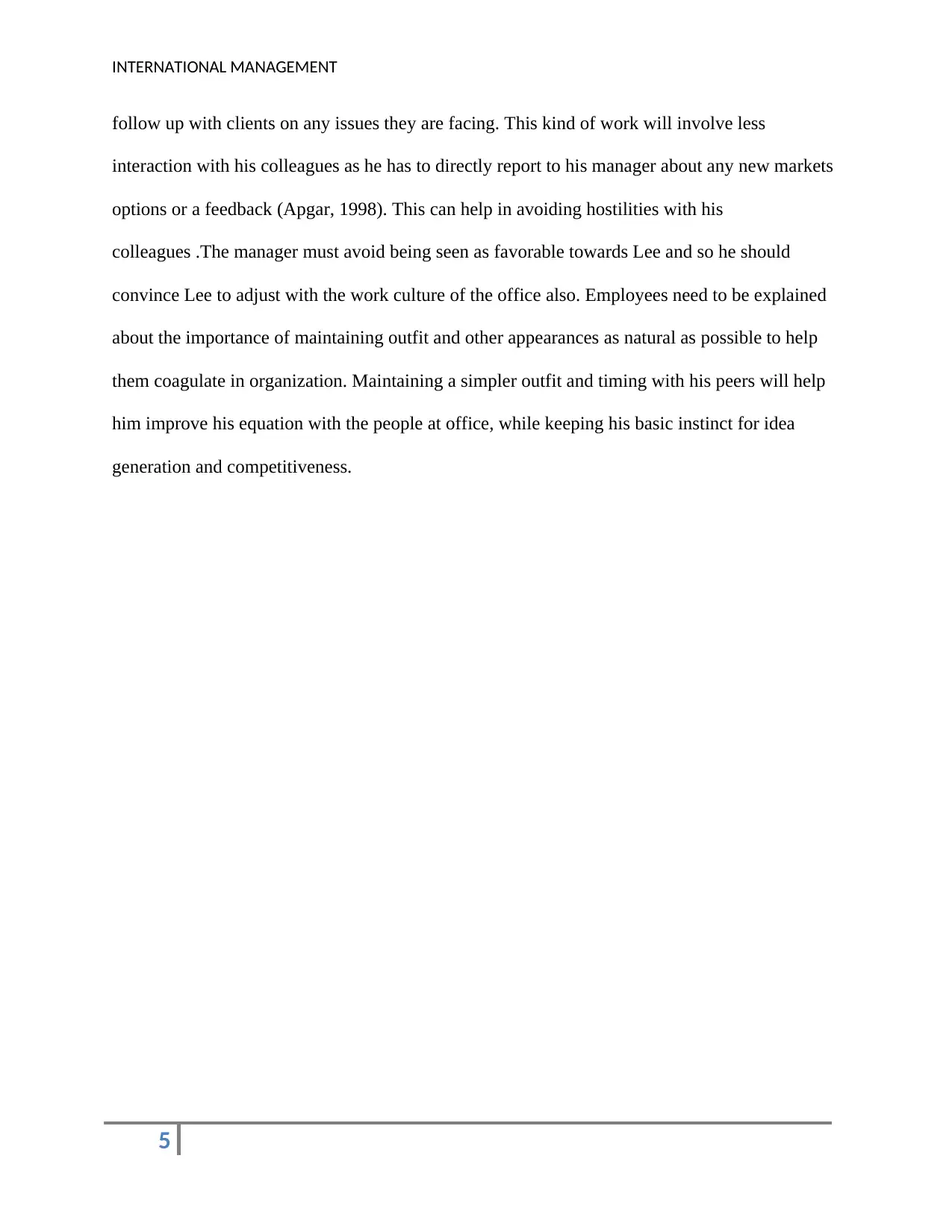
INTERNATIONAL MANAGEMENT
follow up with clients on any issues they are facing. This kind of work will involve less
interaction with his colleagues as he has to directly report to his manager about any new markets
options or a feedback (Apgar, 1998). This can help in avoiding hostilities with his
colleagues .The manager must avoid being seen as favorable towards Lee and so he should
convince Lee to adjust with the work culture of the office also. Employees need to be explained
about the importance of maintaining outfit and other appearances as natural as possible to help
them coagulate in organization. Maintaining a simpler outfit and timing with his peers will help
him improve his equation with the people at office, while keeping his basic instinct for idea
generation and competitiveness.
5
follow up with clients on any issues they are facing. This kind of work will involve less
interaction with his colleagues as he has to directly report to his manager about any new markets
options or a feedback (Apgar, 1998). This can help in avoiding hostilities with his
colleagues .The manager must avoid being seen as favorable towards Lee and so he should
convince Lee to adjust with the work culture of the office also. Employees need to be explained
about the importance of maintaining outfit and other appearances as natural as possible to help
them coagulate in organization. Maintaining a simpler outfit and timing with his peers will help
him improve his equation with the people at office, while keeping his basic instinct for idea
generation and competitiveness.
5
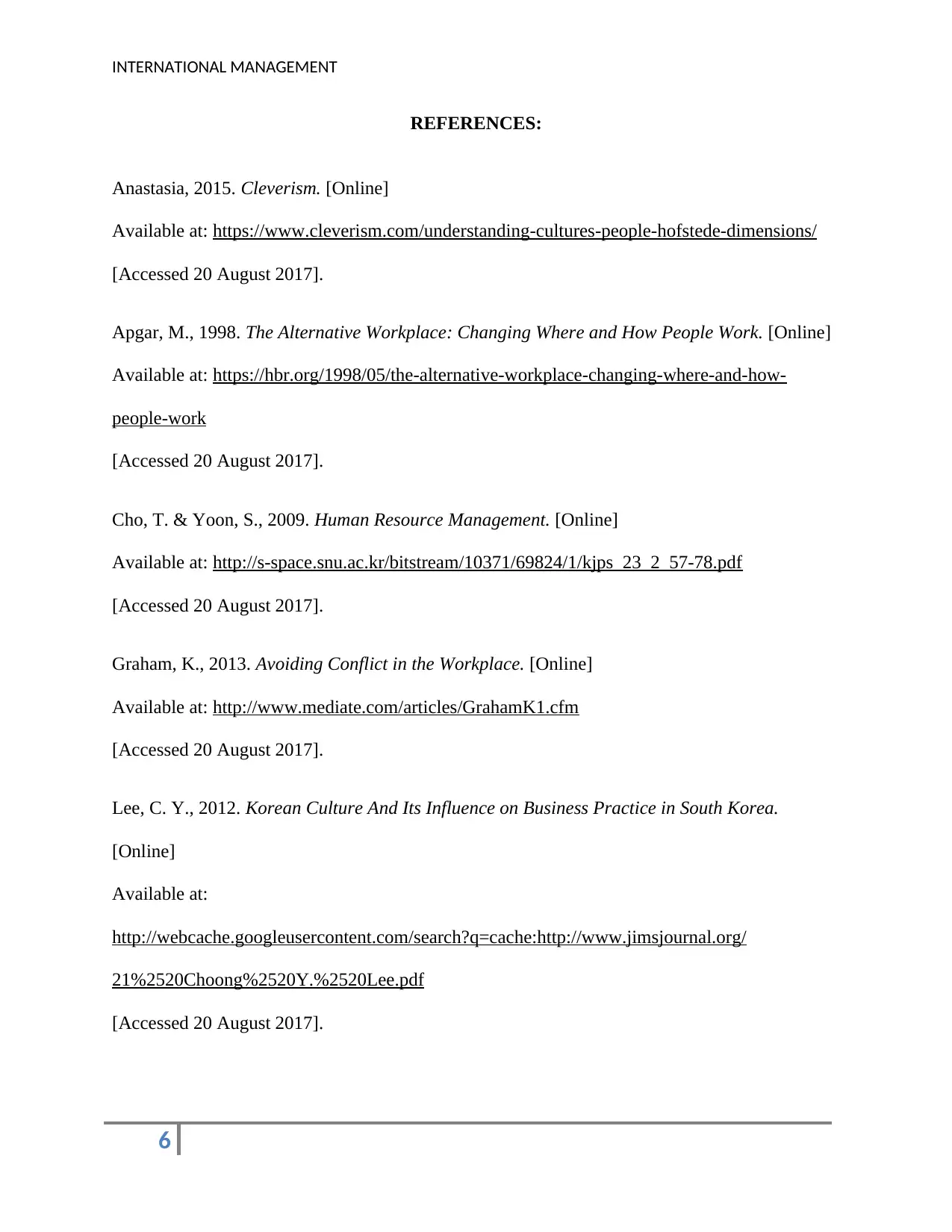
INTERNATIONAL MANAGEMENT
REFERENCES:
Anastasia, 2015. Cleverism. [Online]
Available at: https://www.cleverism.com/understanding-cultures-people-hofstede-dimensions/
[Accessed 20 August 2017].
Apgar, M., 1998. The Alternative Workplace: Changing Where and How People Work. [Online]
Available at: https://hbr.org/1998/05/the-alternative-workplace-changing-where-and-how-
people-work
[Accessed 20 August 2017].
Cho, T. & Yoon, S., 2009. Human Resource Management. [Online]
Available at: http://s-space.snu.ac.kr/bitstream/10371/69824/1/kjps_23_2_57-78.pdf
[Accessed 20 August 2017].
Graham, K., 2013. Avoiding Conflict in the Workplace. [Online]
Available at: http://www.mediate.com/articles/GrahamK1.cfm
[Accessed 20 August 2017].
Lee, C. Y., 2012. Korean Culture And Its Influence on Business Practice in South Korea.
[Online]
Available at:
http://webcache.googleusercontent.com/search?q=cache:http://www.jimsjournal.org/
21%2520Choong%2520Y.%2520Lee.pdf
[Accessed 20 August 2017].
6
REFERENCES:
Anastasia, 2015. Cleverism. [Online]
Available at: https://www.cleverism.com/understanding-cultures-people-hofstede-dimensions/
[Accessed 20 August 2017].
Apgar, M., 1998. The Alternative Workplace: Changing Where and How People Work. [Online]
Available at: https://hbr.org/1998/05/the-alternative-workplace-changing-where-and-how-
people-work
[Accessed 20 August 2017].
Cho, T. & Yoon, S., 2009. Human Resource Management. [Online]
Available at: http://s-space.snu.ac.kr/bitstream/10371/69824/1/kjps_23_2_57-78.pdf
[Accessed 20 August 2017].
Graham, K., 2013. Avoiding Conflict in the Workplace. [Online]
Available at: http://www.mediate.com/articles/GrahamK1.cfm
[Accessed 20 August 2017].
Lee, C. Y., 2012. Korean Culture And Its Influence on Business Practice in South Korea.
[Online]
Available at:
http://webcache.googleusercontent.com/search?q=cache:http://www.jimsjournal.org/
21%2520Choong%2520Y.%2520Lee.pdf
[Accessed 20 August 2017].
6
⊘ This is a preview!⊘
Do you want full access?
Subscribe today to unlock all pages.

Trusted by 1+ million students worldwide
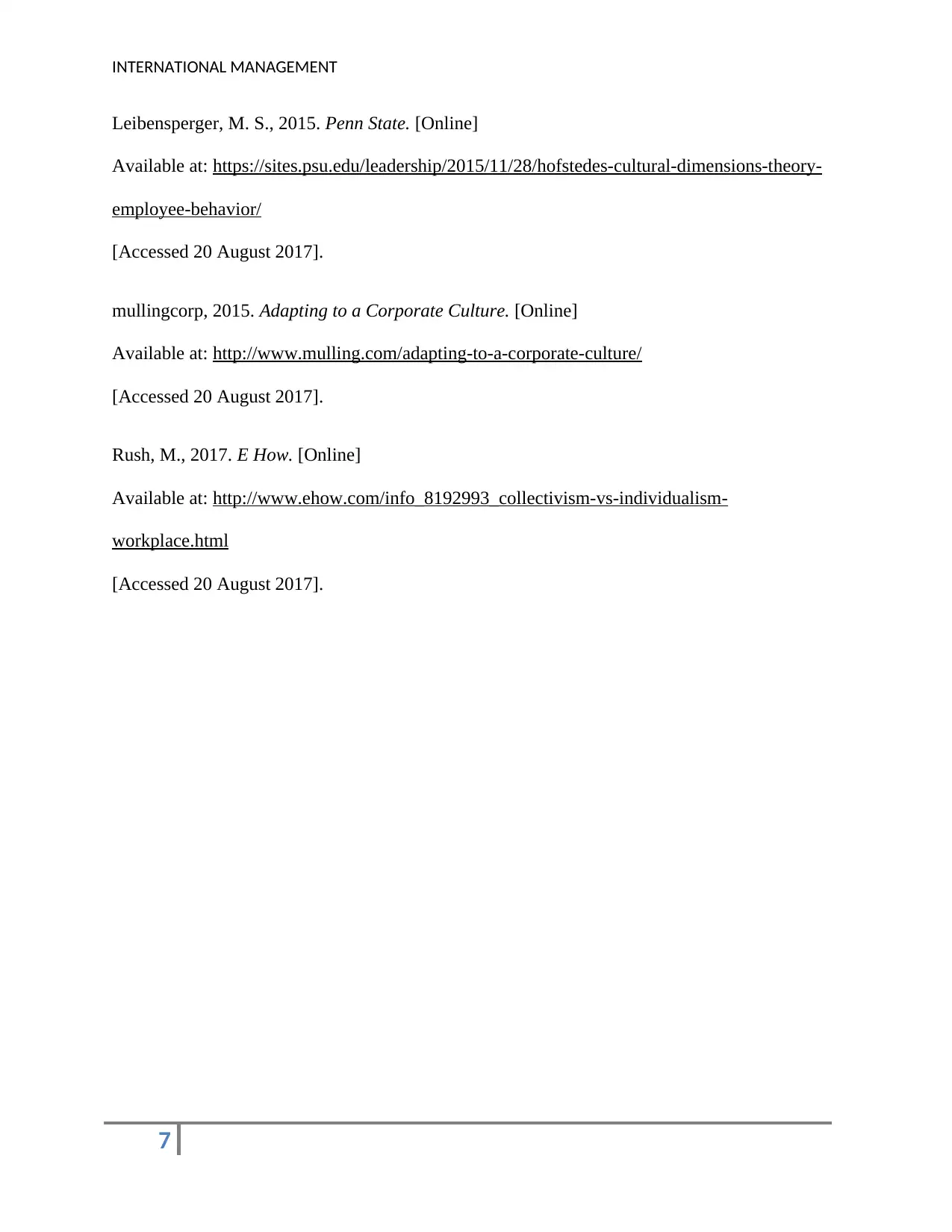
INTERNATIONAL MANAGEMENT
Leibensperger, M. S., 2015. Penn State. [Online]
Available at: https://sites.psu.edu/leadership/2015/11/28/hofstedes-cultural-dimensions-theory-
employee-behavior/
[Accessed 20 August 2017].
mullingcorp, 2015. Adapting to a Corporate Culture. [Online]
Available at: http://www.mulling.com/adapting-to-a-corporate-culture/
[Accessed 20 August 2017].
Rush, M., 2017. E How. [Online]
Available at: http://www.ehow.com/info_8192993_collectivism-vs-individualism-
workplace.html
[Accessed 20 August 2017].
7
Leibensperger, M. S., 2015. Penn State. [Online]
Available at: https://sites.psu.edu/leadership/2015/11/28/hofstedes-cultural-dimensions-theory-
employee-behavior/
[Accessed 20 August 2017].
mullingcorp, 2015. Adapting to a Corporate Culture. [Online]
Available at: http://www.mulling.com/adapting-to-a-corporate-culture/
[Accessed 20 August 2017].
Rush, M., 2017. E How. [Online]
Available at: http://www.ehow.com/info_8192993_collectivism-vs-individualism-
workplace.html
[Accessed 20 August 2017].
7
1 out of 7
Related Documents
Your All-in-One AI-Powered Toolkit for Academic Success.
+13062052269
info@desklib.com
Available 24*7 on WhatsApp / Email
![[object Object]](/_next/static/media/star-bottom.7253800d.svg)
Unlock your academic potential
Copyright © 2020–2025 A2Z Services. All Rights Reserved. Developed and managed by ZUCOL.





